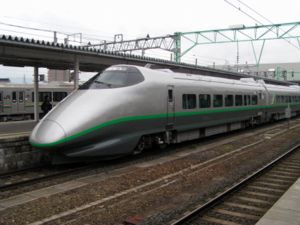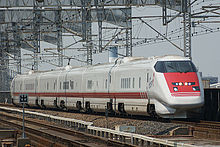- Mini-shinkansen
-
Mini-shinkansen (ミニ新幹線) is the name given to the concept of converting 1,067 mm (3 ft 6 in) narrow gauge railway lines to 1,435 mm (4 ft 8 1⁄2 in) standard gauge for use by Shinkansen train services in Japan. Two mini-shinkansen routes have been constructed: the Yamagata Shinkansen and Akita Shinkansen.[1]
Contents
Concept
The Mini-shinkansen concept was first developed in JNR days, but was not formally proposed until November 1987, following the formation of East Japan Railway Company (JR East). The concept involved regauging existing Cape gauge lines to standard gauge and linking them to the Shinkansen network to allow through-running. While the track gauge was widened, the loading gauge remained unchanged, requiring the construction of new shinkansen trains with a narrower cross-section. These would be capable of running at high-speed (over 200 km/h) on shinkansen tracks, either on their own or coupled to full-sized sets, and run at conventional narrow-gauge speeds (around 130 km/h) on the mini-shinkansen tracks. Speeds on converted lines would also be raised where possible.[1]
Yamagata Shinkansen
Main article: Yamagata ShinkansenThe first mini-shinkansen route to be built was the Yamagata Shinkansen, converted from the 90 km section of the Ōu Main Line between Fukushima on the Tōhoku Shinkansen and Yamagata in Yamagata Prefecture. Work started in 1988, with Yamagata Shinkansen services commencing on 1 July 1992. Services were operated by a new fleet of 400 Series Shinkansen trains, at up to 240 km/h on the Tōhoku Shinkansen and 130 km/h on the Yamagata Shinkansen section.[2]
Akita Shinkansen
Main article: Akita ShinkansenFollowing the success of the Yamagata Shinkansen conversion, a scheme was proposed to construct a second mini-shinkansen route from Morioka in Iwate Prefecture, then the northern terminus of the Tōhoku Shinkansen, with Akita in Akita Prefecture. This involved regauging the 75.6 km Tazawako Line from Morioka to Ōmagari and 51.7 km of the Ōu Main Line from Ōmagari to Akita.[1] This opened on 22 March 1997 with services using new E3 Series Shinkansen trains.[2]
Rolling stock
The following rolling stock was built for use on mini-shinkansen lines.
- 400 Series Shinkansen, Yamagata Shinkansen (1992–2009)
- E3 Series Shinkansen, Akita Shinkansen (1997–) and Yamagata Shinkansen (1999–)
- E926 East i track and overhead wire inspection train (2001–)
- E955 Fastech 360Z experimental test train (2006–2008)
- E6 Series Shinkansen, planned for Akita Shinkansen from 2013
See also
- Gauge Change Train, an experimental train designed to operate on both narrow-gauge and standard-gauge routes
- Super Tokkyū, a concept of building narrow-gauge lines to Shinkansen standards
References
Shinkansen Lines in service Main lines Mini-Shinkansen
Future lines Cancelled lines Service names In service Discontinued Aoba • AsahiTrainsets In service 100 Series • 200 Series • 300 Series • 500 Series • 700 Series • N700 Series • 800 Series • E1 Series • E2 Series • E3 Series • E4 Series • E5 SeriesOn order E6 Series • L0 seriesRetired Export trainsets Non-revenue
earning trainsetsClass 1000 • Class 951 • Class 961 • Class 962 • Doctor Yellow • WIN350 • STAR21 • 300X • Fastech 360 • Gauge Change Train • MLX-01Operators Categories:
Wikimedia Foundation. 2010.



